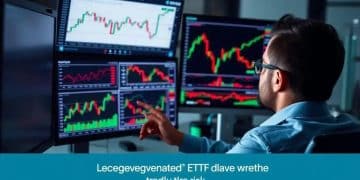Economic indicators affecting consumer confidence: what to watch

Economic indicators affecting consumer confidence include unemployment rates and the Consumer Confidence Index, which directly influence spending habits and overall consumer perceptions of financial stability.
Economic indicators affecting consumer confidence play a crucial role in how we make spending decisions. Curious about which factors create a ripple effect in the economy? Let’s dive into the data that influence your wallet.
What are economic indicators?
Economic indicators are vital statistics that reflect the overall economic health of a country. They are used by businesses, investors, and policymakers to make informed decisions. Understanding these indicators can help you predict trends and prepare for changes in the economy.
Types of Economic Indicators
There are three main types of economic indicators: leading, lagging, and coincident indicators. Each type plays a different role in helping us gauge the state of the economy.
- Leading Indicators: These predict future economic activity. Examples include stock market performance and new housing permits.
- Lagging Indicators: These confirm trends after they occur. Examples include unemployment rates and consumer spending.
- Coincident Indicators: These occur in real-time with economic activity. Examples include GDP and retail sales.
Beyond these categories, individual indicators can reveal much about consumer behavior. For example, the Consumer Price Index (CPI) measures changes in prices that consumers pay for goods and services. It indicates whether prices are rising or falling, affecting consumer confidence.
Another important indicator is the Gross Domestic Product (GDP), which represents the total value of goods and services produced in a country. A growing GDP often signals a healthy economy, while a shrinking GDP may point to economic troubles.
Moreover, indicators also serve as a reflection of public sentiment. Surveys such as the Consumer Confidence Index assess how optimistic consumers feel about the economy. High consumer confidence usually leads to increased spending, which can bolster economic growth.
Key indicators that signal consumer confidence

Understanding the key indicators that signal consumer confidence is essential for businesses and individuals alike. These indicators provide insights into how optimistic consumers feel about their financial situations and the economy as a whole.
Consumer Confidence Index (CCI)
The Consumer Confidence Index (CCI) is one of the most critical metrics. It measures how confident consumers are in the economic stability and their personal financial situations. A high CCI implies that consumers are willing to spend, whereas a low CCI may indicate caution.
Retail Sales Data
Another important indicator is retail sales data. This metric tracks the total sales at retail stores and is a clear reflection of consumer spending habits. When retail sales rise, it typically signifies that consumers are confident and willing to make purchases.
- Growth trends: Consistent increases in retail sales can indicate rising consumer confidence.
- Seasonal adjustments: Sales during holidays and events are often higher, showing spikes in confidence.
- Regional differences: Some areas may see stronger retail sales, reflecting localized economic conditions.
The Unemployment Rate is also a significant indicator. A lower unemployment rate suggests that more people are working, which usually leads to increased spending and confidence. Conversely, a high unemployment rate indicates economic struggles, leading consumers to hold back on spending.
Lastly, Economic Sentiment Surveys from organizations like the Conference Board offer valuable insights. These surveys gauge the overall mood of consumers, revealing how they feel about current and future economic conditions.
How economic indicators influence spending habits
Economic indicators play a crucial role in shaping how consumers decide to spend their money. These indicators provide insights into the economy that can directly impact consumer behavior. When people feel confident about their financial situation, they are more likely to spend.
The Effect of Economic Growth
As the economy grows, indicators such as GDP increase. A rising GDP often boosts consumer confidence, leading to greater spending. When consumers see that the economy is improving, they tend to make larger purchases, knowing they feel secure in their financial future.
Impact of Unemployment Rates
The unemployment rate is another key indicator that influences consumer spending. When the unemployment rate is low, it means more people are employed and earning money. This generally encourages higher spending. In contrast, high unemployment rates lead to uncertainty, causing consumers to tighten their budgets.
- Job security: Employed individuals are likely to feel financially secure and spend more on non-essential items.
- Budget adjustments: People may cut back spending on luxury goods when job security is uncertain.
- Economic signaling: The perception of job availability can drive spending behaviors significantly.
Interest rates also play a significant role in shaping spending habits. When interest rates are low, borrowing becomes cheaper. Consumers are more inclined to take loans or use credit cards for larger purchases, such as homes or cars. This increase in borrowing can lead to a surge in consumer spending, as financing options make it easier for individuals to buy big-ticket items.
Moreover, inflation is another indicator that cannot be ignored. When inflation rises, consumers may find their purchasing power diminished. In such situations, they may adjust their spending habits to focus on essential goods, reducing expenditure on discretionary items.
The role of media in shaping consumer perceptions

The media plays a significant role in shaping consumer perceptions and can greatly influence how individuals view the economy and their spending habits. Through various channels like television, newspapers, and social media, the media disseminates information that can either boost or diminish consumer confidence.
Influence of News Coverage
News coverage on economic issues has a direct impact on consumer sentiment. When the media highlights positive developments, such as rising employment rates or stock market gains, it often leads consumers to feel more optimistic about their financial situation. Conversely, negative news, such as reports of high unemployment or economic downturns, can create anxiety and cause consumers to hold back on spending.
- Positive Reporting: Celebratory reports of successful companies can increase consumer spending.
- Negative Reporting: Alarmist articles about economic crises may lead to decreased consumer confidence.
- Influencer Impact: Social media influencers can sway opinions and shape perceptions about products and services.
Moreover, advertising plays a crucial role in this dynamic. Advertisements crafted to resonate with consumers can enhance their perception of value and quality. When consumers see compelling ads that convey confidence in products, they are more likely to make purchases. This ability to foster desire and brand loyalty is powerful.
Social media platforms have also changed the landscape by allowing consumers to share their experiences and opinions widely. User-generated content, such as reviews and testimonials, can significantly affect public perception. When consumers see positive reviews, they are likely to feel more secure in their purchasing decisions.
Additionally, trending topics can shift consumer focus rapidly. For example, discussions about sustainability and ethical consumption can influence buyer behavior. Consumers may choose to support brands that align with their values, often providing a competitive edge to those companies in the market.
FAQ – Questions about economic indicators and consumer confidence
What are economic indicators?
Economic indicators are statistics that provide insights into the economic health of a country, influencing consumer decisions.
How does consumer confidence affect spending?
High consumer confidence usually leads to increased spending, as people feel secure about their financial future.
What role does the media play in shaping consumer perceptions?
The media influences consumer perceptions by how economic news is reported, affecting confidence and spending behavior.
Why are unemployment rates important economic indicators?
Unemployment rates indicate job security, which directly impacts consumer confidence and their willingness to spend.





